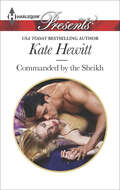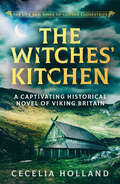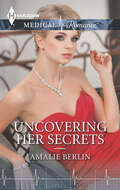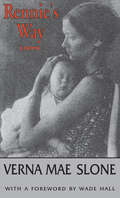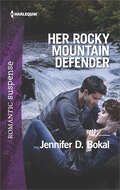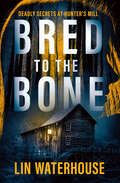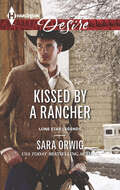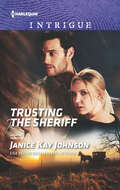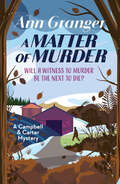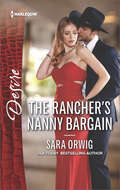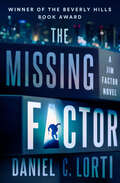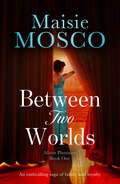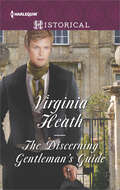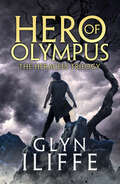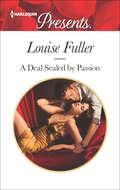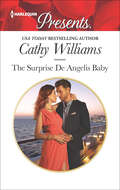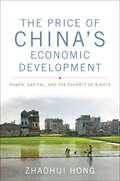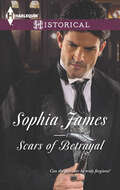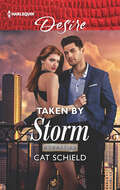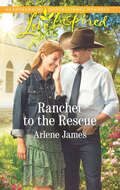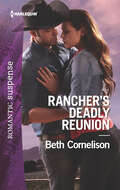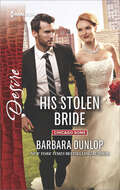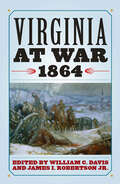- Table View
- List View
Commanded by the Sheikh (Rivals to the Crown of Kadar #2)
by Kate HewittWhen a desert king needs an imposter bride, he finds true passion with his shy housekeeper in this sexy royal romance.When his fiancée goes missing, Sheikh Aziz al Bakhir needs someone trustworthy to impersonate her until she’s found. So the legendary lothario of Europe demands that his housekeeper, Olivia Ellis, fulfill the role! Olivia thought Kadar was the perfect place to hide from scandal. But playing the sheikh’s betrothed will put her in an unwelcome spotlight. And on top of the global scrutiny, she’ll have to withstand his seductive silver gaze! As ruthless as his desert ancestry, Aziz crashes through her reluctance, and Olivia soon finds herself playing his queen in public . . . and his lover in bed!
The Witches' Kitchen (The Life and Times of Corban Loosestrife)
by Cecelia Holland&“Interweaves . . . romance, magic, and suspense into a superlative historical epic featuring a stoic hero often at odds with the all-powerful Viking warriors.&” —Booklist Corban Loosestrife, his family slain by Viking raiders, has saved his twin sister Mav from the clutches of her Viking abductors, and wrought bloody revenge on Eric Bloodaxe, the King of Jorvik. After fleeing with his family from the war of succession to Vinland, he feels they have finally earned some peace. But then a ship appears on the horizon, bringing Corban a summons to Jorvik and the murderous intrigues of those who would be king. Corban, his son, Conn, and his sister&’s son, Raef—young men ready to prove themselves in battle—must return into this nest of vipers and navigate the deadly political war for the ultimate prize: the Viking throne . . . The Witches&’ Kitchen is second in the epic Life and Times of Corban Loosestrife series, perfect for fans of James L. Nelson, Ben Kane and Adrian Goldsworthy. &“A potent blend of fantasy, history and romance. . . . A rousing, vivid tale rich with Nordic lore.&” —Publishers Weekly &“Holland fleshes out a lively account of the time of Eric Bloodaxe. Recommended.&” —Library Journal
Uncovering Her Secrets
by Amalie BerlinTwo doctors re-examine their relationship when mistrust gives way to passion . . .Hiring her ex, the irresistible Dr. Preston Monroe, is Dr. Dasha Hardin’s secret atonement for her unforgivable past. But her plan is suddenly complicated by his touch, which still makes her heart beat a little too fast . . .Preston has no choice but to reluctantly trust Dasha—even if he can’t fully forgive her, not after what she did to him years ago. And soon he wants to discover more about this newly feisty, vulnerable woman—the only woman with the strength to fight for his irredeemable soul. . . .
Rennie's Way: A Novel
by Verna Mae Slone“An intriguing mix of family history, lore, mountain culture, and folkways, skillfully bound together with an all-but-transparent thread of fiction.” —Library JournalWhen Rennie Slone’s mother dies in childbirth, the twelve-year-old girl is unexpectedly thrust into adulthood. She must keep house for her father, an itinerant preacher who finds little time for family, and raise her newborn sister—a task that becomes Rennie’s lifelong passion. Against all odds, she is determined that Sarah Ellen will have the education she herself has had to give up.This first work of fiction by Verna Mae Slone, firmly grounded in her own background, is set in the 1920s and 1930s in a closeknit community in eastern Kentucky, where family roots run deep. At its center stands as strong and resilient a heroine as any in American literature. The story of Rennie’s struggles and Sarah Ellen’s growth into womanhood form a richly textured picture of the simple, sturdy mountain people—their labor to wrest a living from the land, their neighborly care for one another, their shared joys, their quarrels with the outside world, and their distinctive dialect. We see the people of Lonesome Holler raising and preserving food, gathering for bean stringings, molasses stir-offs, play parties, and pie socials, pitching in to clear a neighbor’s land, assisting at a difficult birth, and helping to bury the dead.Verna Mae Slone, a native of Knott County, Kentucky, is the author of several books, including the bestselling memoir, What My Heart Wants to Tell.“Slone’s style, which includes dialogue written in dialect, is lively. Readers drawn to regional tales will enjoy learning about Lonesome Holler.” —Publishers Weekly
Her Rocky Mountain Defender: Colton And The Single Mom Cavanaugh Vanguard Navy Seal Rescue Her Rocky Mountain Defender (Rocky Mountain Justice #2)
by Jennifer D. BokalA medical student searching for her troubled sister gets caught up with a secret agent investigating a drug cartel in this romantic suspense novel.Searching for her missing sister leads Madelyn Thompkins straight into the path of danger . . . and Roman DeMarco. Wounded physically and emotionally, the undercover agent hardly needs this distraction. When the two collide with a Russian gang, they go on the run—and are drawn together. Their priorities don’t align, but when Madelyn falls victim to a murderous criminal, Roman is ready to sacrifice everything to save her.
Bred to the Bone: Deadly Secrets at Hunter's Mill (Hunter's Mill)
by Lin WaterhouseIn this small-town mystery, a retired teacher moves to the Ozark mountains, where her eager manner ruffles some feathers—and unearths dark secrets. Retired schoolteacher Caroline Hudson has moved to Hickory Bend, Missouri, to embrace small-town life. But her eagerness to join the community only rouses the suspicions of longtime residents. Luckily, her friend Terry needs help fixing up the old Hunter&’s Mill. Caroline is thrilled to learn about her new home through this historic building—especially when she discovers some fascinating documents hidden in the attic. These documents reveal family secrets of prejudice, pride, murder, and mayhem—just the kind of story that piques Caroline&’s curiosity! But some residents would prefer to keep the unpleasantness buried in the past. When someone launches a cover-up as shocking and foolhardy as the original crime, it could bring a permanent end to Caroline&’s new career in sleuthing . . .
Kissed by a Rancher: Triple The Fun Kissed By A Rancher Secret Heiress, Secret Baby (Lone Star Legends #4)
by Sara OrwigA worldly cowboy seeks shelter with a small-town woman—and gets snowed in—in a fairy tale of a Western romance from the USA Today–bestselling author.When a blizzard strands rancher Josh Calhoun at a tiny Texas inn, it’s not boredom that makes him notice innocent Abby Donovan. There’s something about the B & B’s owner, with her ponytail and sweet smile. Now Josh can’t stop wanting her—or kissing her. He refuses to say goodbye . . . When the roads clear, Abby lets herself be whisked away—to New York City, to Josh’s vast Texas ranch, to a wealthy world she’s never known. Will she stay with the tempting cowboy? Or return to the life she left behind?“Abby and Josh seem to be opposites in every way, but beneath the surface it’s easy to see why the sparks fly. What makes them a stand-out couple is the depth and compassion of their sweetly written romance.” —RT Book Reviews (4 stars)
Trusting the Sheriff: Hostage At Hawk's Landing Trusting The Sheriff Protecting Baby (Mills And Boon Heroes Ser.)
by Janice Kay JohnsonA wounded detective hiding in Amish country faces suspicion from the local sheriff in this tense and twisting romantic thriller.Kansas City detective Abby Baker is wounded in a shootout that leaves her partner dead. Though she has no memory of what happened, her sergeant wonders if she has something to hide. Now, as she takes refuge with her aunt and uncle on their Amish farm, Sheriff Caleb Tanner is tasked with learning Abby’s secrets. But the more Tanner digs, the more he’s drawn to her beauty and resilience. And when danger follows her to the quiet Amish enclave in northern Missouri, Abby and Tanner will have to trust each other in order to stay alive.
A Matter of Murder (A Campbell and Carter Mystery)
by Ann GrangerCampbell and Carter are back in their toughest case yet in the seventh Cotswold village crime novel following An Unfinished Murder. Two years ago, Miff Ferguson chose to opt out of the rat race. Since then he&’s been living rough and happily so. Until now. For as the first signs of winter approach, everything in his life is uprooted. While looking for shelter, Miff stumbles across the corpse of a young woman in a dilapidated warehouse. Quickly realizing he is not alone, and has been spotted, Miff becomes embroiled in a game of cat-and-mouse with a killer that forces him to abandon his life and take refuge with his aunt and uncle in the village of Weston St Ambrose. But despite his best efforts to lie low, trouble seems to follow him everywhere, and when another dead body is discovered at a local farm, it&’s clear Miff is not free from danger. With the clock ticking, Inspector Jess Campbell and Superintendent Ian Carter must join forces with the team of police at Bamford to piece together the puzzle before another innocent life is lost . . . Praise for the writing of Ann Granger &“A well-written, well-crafted traditional British mystery by a writer with an assured grasp of her technique.&” —reviewingtheevidence.com &“Characterization, as ever with Granger, is sharp and astringent.&” —The Times &“The story just gets more complex, mysterious and chilling.&” —Good Book Guide &“For once a murder novel which displays a gentle touch and a dash of wit.&” —The Northern Echo &“A clever and lively book.&” —Margaret York
The Rancher's Nanny Bargain: The Tycoon's Secret Child The Rancher's Nanny Bargain Single Mom, Billionaire Boss (Callahan's Clan #2)
by Sara OrwigThis nanny is strictly off limits, but she’s got a hankering to break some rules. A red-hot Callahan’s Clan novel from the USA Today–bestselling author.Rancher Cade Callahan is desperate. As guardian to his brother’s baby, he’s completely clueless, and he needs a nanny quick! Hiring his best friend’s very qualified sister seems like a no-brainer. But Erin Dorsey isn’t the scrawny kid he remembers, and the ravishing redhead has him reeling. Cade has no use for marriage and likes to play the field. Erin is vulnerable because of a recent heartbreak, so Cade promised her brother to keep his hands off. But resisting the allure of his stunning nanny is easier said than done . . .
The Missing Factor (The Jim Factor Novels)
by Daniel C. LortiA former international arms dealer brings his unique expertise to this twisting, action-packed spy thriller. From his elegant home in Southern California, Jim Factor negotiates legitimate weapons deals for his clients in Europe. But when he&’s approached with a shady job that pays too well to refuse, the one-time deal may be his last. With the Russian mafia after him, Factor must disappear quick—and telling his wife, Diane, anything about the situation would only put her in danger. Hiding out in San Francisco and preparing for a life on the run, Factor is tracked down by a private detective—and the Russians aren&’t far behind. Now his only chance at survival is to fight a ruthless, deadly enemy face-to-face. From Alcatraz Island to Spain and the Balkans, The Missing Factor is an international spy thriller shot through with authentic spy craft.
Between Two Worlds (The Alison Plantaine Sagas)
by Maisie MoscoA young girl is drawn to her dramatic family heritage in the first Alison Plantaine saga from the author of Almonds and Raisins. Alison Plantaine was born to the theatre. As a child the life she knew was one of backstage dramas and highly-charged emotions. The desire to perform is in her Plantaine blood. But when Alison learns about her secret heritage it makes her question the path she has chosen. Meanwhile, tastes are changing and the family passion for acting is losing touch with trends. A war is breaking out and Alison senses change in the air. Her mother is a gifted actress and wants her daughter to follow in her footsteps. Her father, shrewd and practical, understands that his daughter&’s respect for family tradition must not stifle her talent and the promise of success. But the decision must be Alison&’s and she becomes torn between duty and heritage, or the life she always dreamed of on the stage. A vivid and emotional family saga from a much-loved author, perfect for fans of Rita Bradshaw and Margaret Dickinson. Praise for the writing of Maisie Mosco &“Once in every generation or so a book comes along which lifts the curtain.&” —The Guardian &“Full of freshness and fascination.&” —Manchester Evening News &“The undisputed queen of her genre.&” —The Jewish Chronicle
The Discerning Gentleman's Guide: Once Upon A Regency Christmas The Discerning Gentleman's Guide The Runaway Governess
by Virginia HeathA Duke’s marriage plan is undone by passion in a Regency romance that is “classically witty, engaging and so sexy . . . a pure joy to read” (Chicks, Rogues and Scandals).Bennett Montague, sixteenth Duke of Aveley, is seeking the perfect bride. He’s narrowed his search to five worthy “Potentials” . . . until the arrival of his aunt’s companion unravels his carefully laid plans. Having fought for everything she has, Amelia Mansfield is incensed by Bennett’s wife-selection methods. But as she’s forced to spend time in his company, she begins to see another side to Bennett—and that man is infinitely more tantalizing and enticing . . .
Hero of Olympus (The Heracles Trilogy)
by Glyn IliffeSurpass all odds, break the chains, defeat a God—the thrilling, triumphant final installment in The Heracles Trilogy that began with Son of Zeus. Heracles&’ trials are far from over. Carrying the weight of the heavens, accompanied only by his most loyal friend, Iolaus, he will do anything to atone for his crimes. But all is not as it seems. Gods and men alike plot against him . . . First Heracles must obtain the girdle of the Amazonian Queen, Hippolyta, steal cattle from the monstrous Geryon, and take apples from the Garden of Hesperides. Through it all Heracles will come to realize his betrayal is more complete than he could ever have imagined. Ultimately, to release himself from his suffering, he must journey deep into Hades, and face death itself . . .
A Deal Sealed by Passion: Helios Crowns His Mistress The Surprise De Angelis Baby The Sheikh's Pregnant Prisoner A Deal Sealed By Passion
by Louise FullerA wealthy Italian playboy’s new property includes a beautiful tenant who’s not leaving without a fight in this sexy contemporary romance.Tycoon Massimo Sforza learned from a young age that emotions are for the weak. He relishes crushing his opponents in the boardroom as much as he enjoys the many women who grace his bed. But his newest adversary is like none he’s ever met before . . .Free-spirited gardener Flora Golding is all that stands between Massimo and the acquisition of the stunning Italian palazzo she’s hiding herself away in—but his plan to seduce the antagonistic beauty only serves to make this deal even sweeter! Only Massimo hasn’t counted on Flora’s passion blurring that vital line between business and pleasure . . .
The Surprise De Angelis Baby: Leonetti's Housekeeper Bride / The Surprise De Angelis Baby (The Italian Titans #2)
by Cathy WilliamsAn undercover billionaire’s sexy fling at sea could lead to the most important merger of his life in this romance by a USA Today–bestselling author.Billionaire businessman Daniel De Angelis’s plan was simple: a few undercover days at sea to uncover the weaknesses of the ship he plans to acquire. Instead he discovers a vulnerability of his own—gorgeous art teacher Delilah Shaw!The terms of their liaison were clear: two weeks of complete sensual surrender that ends the moment the cruise ship docks. But stepping back onto dry land brings Delilah back to earth in more ways than one. Now she’s facing two very shocking truths: Daniel lied about his identity while tempting her . . . and now she’s pregnant with his baby!
The Price of China's Economic Development: Power, Capital, and the Poverty of Rights (Asia In The New Millennium Ser.)
by Zhaohui Hong“This work provides a theoretically sophisticated analysis of major political, social, economic, and cultural trends in China.” —Roger des Forges, author of Chinese Walls in Time and SpaceThe People’s Republic of China has experienced significant transformations since Deng Xiaoping instituted economic reforms in 1978. Subsequent leaders continued and often broadened Deng’s policies, shifting the nation from agrarianism to industrialism, from isolation to internationalism, and from centralized planning to market-based economics. As the world strives to understand the nation’s rapid development, few observers have comprehensively examined the social and cultural price of the economic boom for the majority of the Chinese people.Zhaohui Hong assesses the sociocultural consequences of these reforms in this provocative study. He contends that modern China functions as an oligarchy or plutocracy ruled by an alliance of political power and private capital where the boundaries between the private and public sectors are constantly shifting. This “power-capital institution” based on three millennia of Confucian ideology and decades of Maoist communism exercises monopolistic control of public resources at the expense of civil society and social justice for the majority of citizens.The Price of China’s Economic Development urges policymakers to alter their analytic lens. While industrial and commercial development is quantitatively measured, Hong argues that social progress should be assessed qualitatively, with justice its ultimate goal and fair allocation of resources and opportunity as the main index of success. This sophisticated analysis introduces English speakers to the varied and significant work of contemporary Chinese scholars and substantially enriches the international dialogue.“Presents a new perspective on China’s economic growth and ongoing political problems.” —Xiaobing Li, author of China’s War in Korea
Scars of Betrayal: Mistletoe Magic, Mistress At Midnight, Scars Of Betrayal (Men of Danger #3)
by Sophia JamesAn English aristocrat reunites with the irresistible woman who left him for dead in this Victorian romance.The long-kept secret . . .Cassandra Northrup had believed Nathaniel dead . . . until now. Once, she had loved him, given herself to him in the hidden depths of the snow-covered Pyrenees. But then she had betrayed him. . . .Relief at the sight of Nathaniel turns to darkest shame as Cassie sees the hate in his eyes. Years have passed and their physical scars have faded, but the pain runs deeper than ever. Yet passion can be born out of betrayal—and as desire crackles between them once more, will Cassie reveal the secret she’s long kept hidden?“Book three of James’s Men of Danger trilogy, is rife with honor, betrayal, spies, murder, love and sacrifice. It’s about estranged lovers, shattered dreams and endless guilt. Readers will enjoy the conclusion to this series with its heightened tension, authentic characters and desperate situations.” —RT Book Reviews
Taken by Storm: Taken By Storm (dynasties: Secrets Of The A-list) / The Billionaire's Bargain (blackout Billionaires) (Dynasties: Secrets of the A-List #2)
by Cat SchieldA woman on a romantic mission brings some play into the life of a man who&’s all about work in this sultry follow-up to Karen Booth&’s Tempted by Scandal.&“You don&’t believe in romance? Let me change your mind . . .&” Concierge Isabel Withers vows to turn The Opulence hotel into Seattle&’s top romantic destination. But first she has to convince Shane Adams, her no-nonsense boss, that the project has merit. When a freak storm strands them at the hotel—leading to a night of passion—it more than demonstrates her point. But is the self-proclaimed romance expert in over her head this time?Praise for the novels of Cat Schield &“Cat Schield knows how to write a captivating romance . . . a joy to read.&” —CataRomance.com &“A Cinderella story that will have readers clamoring for more.&” —Harlequin Junkie &“It&’s charming and fluffy and full of tropes that bring comfort and delight!&” —Fresh Fiction
Nothing Less Than War: A New History of America's Entry into World War I (Studies In Conflict, Diplomacy And Peace Ser.)
by Justus D. Doenecke“An equally meticulous and lucid account” of the controversy that preceded the United States’ declaration of war in April 1917 (Historynet).When war broke out in Europe in 1914, political leaders in the United States were swayed by popular opinion to remain neutral; yet less than three years later, the nation declared war on Germany. In Nothing Less Than War: A New History of America’s Entry into World War I, Justus D. Doenecke examines the clash of opinions over the war during this transformative period and offers a fresh perspective on America’s decision to enter World War I.Praise for Nothing Less Than War“Nothing Less Than War combines careful attention to diplomacy with an excellent consideration of politics and public opinion. It is superb in detail, and even scholars well versed in the field will learn things they didn’t know before.” —John Milton Cooper Jr., author of Woodrow Wilson: A Biography“Nothing Less Than War is a thoughtful look at America’s entry into World War I. Based on impressive research, it carries the reader back to a very different time, reassesses the wide-ranging debate over the war in Europe, and provides a stimulating re-examination of the strengths and weaknesses of Woodrow Wilson’s leadership.”?Charles Neu“Doenecke paints intriguing portraits of leading figures, many now obscure, including Franklin Delano and Theodore Roosevelt and William Jennings Bryan, plus the rich stew of newspapers, magazines, organizations, diplomats, and propagandists who fought over this issue.” —Publisher Weekly (starred review)“Doenecke untangles and clarifies the national debate in great detail in this dense, well-documented study. It will be of great use to serious students and researchers of the Great War.” —Library Journal
Rancher to the Rescue (Three Brothers Ranch)
by Arlene JamesFirst comes saving a woman’s day . . . then comes healing his own heart. A Smith brother takes love one step at a time in this heartwarming romance.Coming to the aid of a woman in her broken-down car, Jake Smith finds the answer to his childcare problems. Kathryn Stepp needs a job, and the widower needs a nanny for his son. As they help each other, Jake is caught between attraction and his refusal to marry again. But sometimes a woman doesn’t just fall for a hero—she rescues him right back.
Rancher's Deadly Reunion: The Pregnant Colton Witness Rancher's Deadly Reunion Soldier Bodyguard Trained To Protect (The McCall Adventure Ranch #1)
by Beth CornelisonWhen a woman comes back to her family’s Colorado ranch, an old flame is rekindled, and deadly secrets come to light, in this suspenseful Western romance.When Piper McCall returns to her small Colorado hometown, she runs smack into ranch hand Brady Summers, the man she left behind. Though they were very much in love through high school, Piper was determined to spread her wings. Years later, the sparks between them burn as brightly as ever, but dark secrets—like the identity of his orphaned nephew—linger.As trouble at the McCall ranch escalates, and Piper’s life is threatened, Brady will do anything to protect the woman he loves. To find out who’s behind it, buried secrets will have to be revealed . . . and neither Piper nor Brady will ever be the same again.
His Stolen Bride: The Baby Inheritance A Little Surprise For The Boss His Stolen Bride (Chicago Sons #4)
by Barbara DunlopA PI vows to love, honor and abduct a beautiful bride in this exhilarating romance from the New York Times–bestselling author of A Bargain with the Boss.RITA Award Finalist for Best Short Contemporary Romance“Will you take this woman?” Yes. As a favor to his estranged father, investigator Jackson Rush agrees to kidnap Crista Corday from her high society wedding. His job is to stop her marriage to a con man, not seduce the alluring Crista himself. But two days together, on the run from her fiancé’s shady family, obliterate every rule . . .Crista has no idea of the danger drawing near. Jackson can’t reveal it without divulging who really sent him. And that’s a risk that could cost him everything . . . unless Crista will put herself under his passionate protection forever.
Virginia at War, 1864 (Virginia at War)
by William C. Davis And James I. Robertson Jr.The fourth collection of essays in this Civil War series “serves to remind us that there is much for us to discover beyond Virginia’s battlefields” (H-Net Reviews).The fourth book in the Virginia at War series casts a special light on vital home front matters in Virginia during 1864. Following a year in which only one major battle was fought on Virginia soil, 1864 brought military campaigning to the Old Dominion. For the first time during the Civil War, the majority of Virginia’s forces fought inside the state’s borders. Yet soldiers were a distinct minority among the Virginians affected by the war. In Virginia at War, 1864, scholars explore various aspects of the civilian experience in Virginia including transportation and communication, wartime literature, politics and the press, higher education, patriotic celebrations, and early efforts at reconstruction in Union-occupied Virginia. The volume focuses on the effects of war on the civilian infrastructure as well as efforts to maintain the Confederacy. As in previous volumes, Virginia at War, 1864 concludes with an annotated excerpt from the Diary of a Southern Refugee During the War by Richmond’s Judith Brockenbrough McGuire.“The most fully rounded account of Virginia’s wartime experience.” —Charles P. Roland, author of Reflections on Lee: A Historian’s Assessment“This book covers some interesting areas of lesser-known history of Virginia during the Civil War.” —The Oklahoman
Her Fresh Start Family: The Amish Suitor Reunited With The Bull Rider Her Fresh Start Family (Mississippi Hearts #1)
by Lorraine BeattyA young widow finds a new life and a new love in a little Mississippi town—but will a secret bring it all crashing down?Struggling with a tragic loss, widow Nina Johnson seeks a fresh start in a small Southern town. Then she meets handsome veteran Bret Sinclair and his sweet daughters. Bret’s no stranger to loss, and his companionship is the solace Nina’s been searching for.Until a dark secret from Bret’s past is exposed, threatening to break two hearts . . .
